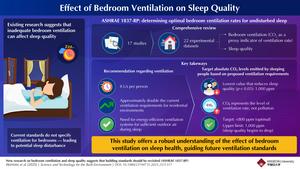Good sleep is key to good health, overall well-being, and optimal cognitive function. Disturbed sleep or lack of sleep can lead to various health issues such as cardiovascular diseases, cancer, and other morbidity, including Alzheimer’s disease and obesity. Therefore, it is necessary to ensure that environmental factors that affect sleep quality, including temperature, noise, light, and air quality, are maintained optimally in the bedroom. Recent studies have consistently shown that inadequate bedroom ventilation can disturb sleep quality. Using these studies, it is possible to revisit the existing ventilation recommendations in bedrooms in a more comprehensive way.
Building on these foundations, in an innovative study, a research team led by Ms. Mizuho Akimoto, a Research Associate at the Advanced Collaborative Research Organization for Smart Society (ACROSS), Waseda University, Japan, together with Professor Shin-ichi Tanabe from the Department of Architecture, Waseda University; Prof. Pawel Wargocki from the Department of Environmental and Resource Engineering, Technical University of Denmark; and Prof. Li Lan from Shanghai Jiao Tong University, has recently conducted a novel analysis as a part of the project sponsored by ASHRAE (1837-RP); Prof. Wargocki and Prof. Lan were Principal Investigators on the project. The overall aim was to provide input to ventilation standards in bedrooms to ensure that sleep quality is not disturbed by poor bedroom air quality. Their novel findings were made available online on July 21, 2025, and published in Volume 31, Issue 8 of the journal Science and Technology for the Built Environment on September 01, 2025.
Ms. Akimoto highlights the motivation behind their work. “The present study not only incorporates a more representative body of evidence but also introduces several novel perspectives. It provides a multidimensional evaluation of how ventilation influences various sleep parameters, distinguishes between intervention and cross-sectional studies, and considers population-specific carbon dioxide (CO₂) emission rates during sleep.”
The team reviewed 17 studies, including 22 experimental datasets, to determine that the lowest ventilation with outdoor air causing disturbed sleep is when the (absolute) CO₂ concentration reaches 1,000 ppm. They observed that the highest CO2 concentration not causing any effect on sleep was 850 ppm at the lowest ventilation rate, but this cannot be regarded as a No Observed Adverse Effect Level due to sensor accuracy and safety margins. Therefore, the researchers proposed the lowest ventilation with outdoor air in bedrooms to keep CO2 at or below 800 ppm; this is the target on which bedroom ventilation should be based. CO2 in all these recommendations acts as a proxy indicator of ventilation rate, rather than a pollutant. To maintain the recommended target levels of CO2, bedroom ventilation rates would need to be about 8 L/s per person, indicating at least twice the amount prescribed in many current residential standards.
“Our findings suggest that currently prescribed minimum ventilation rates for residences may provide inadequate ventilation for bedrooms and may thus lead to impaired sleep. By identifying target CO2 of 800–1,000 ppm to determine ventilation, the review provides evidence that can support reconsideration of ventilation requirements in building codes. This has implications for the housing industry and ventilation system manufacturers, who face the challenge of balancing energy efficiency with human health. We also propose methods to achieve these levels, though further development is needed,” says Ms. Akimoto.
Therefore, the present findings have potential implications for revising the residential building standards in terms of ventilation in bedrooms. However, properly ventilating bedrooms with sufficient outdoor air, energy usage should be minimized. It is believed that this recommendation will lead to improved sleep quality and holistically enhance the quality of life.
Taken together, the present contributions offer a more robust and nuanced understanding of how bedroom ventilation affects sleep health and provide information relevant for future ventilation guidelines.
***
Reference
Authors: Mizuho Akimoto1,2, Xiaojun Fan3, Li Lan4, Chandra Sekhar5, Shin-ichi Tanabe6, David P. Wyon2, and Pawel Wargocki2
DOI: 10.1080/23744731.2025.2531317
Affiliations: 1Advanced Collaborative Research Organization for Smart Society (ACROSS), Waseda University
2International Centre for Indoor Environment and Energy, Department of Environmental and Resource Engineering, Technical University of Denmark
3Berkeley Education Alliance for Research in Singapore
4Department of Architecture, School of Design, Shanghai Jiao Tong University
5Department of the Built Environment, College of Design and Engineering, National University of Singapore
6Department of Architecture, Waseda University
About Waseda University
Located in the heart of Tokyo, Waseda University is a leading private research university that has long been dedicated to academic excellence, innovative research, and civic engagement at both the local and global levels since 1882. The University has produced many changemakers in its history, including eight prime ministers and many leaders in business, science and technology, literature, sports, and film. Waseda has strong collaborations with overseas research institutions and is committed to advancing cutting-edge research and developing leaders who can contribute to the resolution of complex, global social issues. The University has set a target of achieving a zero-carbon campus by 2032, in line with the Sustainable Development Goals (SDGs) adopted by the United Nations in 2015.
To learn more about Waseda University, visit https://www.waseda.jp/top/en
About Mizuho Akimoto from Waseda University, Japan
Ms. Mizuho Akimoto is a Research Associate at the Advanced Collaborative Research Organization for Smart Society (ACROSS), Waseda University, Japan. She obtained her master’s degree from the Department of Architecture at Waseda University in 2022. Her research interests include net-zero energy houses, environmental engineering, bedroom ventilation, and thermal insulation. She has authored around 20 research articles on these topics and received over 300 citations.
Disclaimer: AAAS and EurekAlert! are not responsible for the accuracy of news releases posted to EurekAlert! by contributing institutions or for the use of any information through the EurekAlert system.

